Norwegian Air Shuttle Bundle
Who Really Owns Norwegian Air Shuttle?
Navigating the complexities of the aviation industry requires a deep understanding of ownership structures, and for Norwegian Air Shuttle, this is particularly crucial. The Norwegian Air Shuttle SWOT Analysis is a great tool to understand the company's position. The airline's journey from regional beginnings to a major low-cost carrier has been marked by significant ownership shifts.
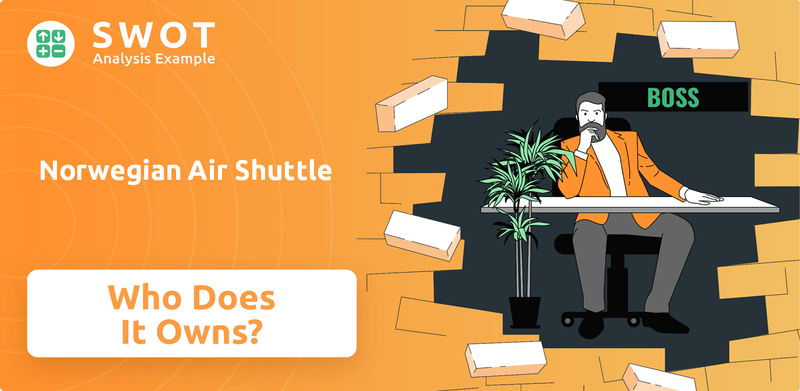
Understanding the current ownership of Norwegian Air Shuttle, including its parent company and major shareholders, is essential for anyone looking to understand its strategic direction and financial health. Recent events, such as the recapitalization in May 2020, have dramatically altered the landscape of who owns Norwegian Air, moving control from its founder to new creditors. This exploration will reveal the key players and the evolution of Norwegian Air ownership, offering valuable insights for investors and industry observers alike.
Who Founded Norwegian Air Shuttle?
The story of Norwegian Air Shuttle began on January 22, 1993. It was founded by former employees of Busy Bee, a regional airline that had ceased operations in December 1992. This marked the start of what would become a significant player in the European aviation market.
Bjørn Kjos, one of the founders, played a pivotal role in the company's early development. He served as CEO from October 2002 until July 2019. Initially, the airline operated with three leased Fokker 50 aircraft, focusing on regional routes in Western Norway.
The initial team comprised approximately fifty employees, based in Bergen, with a technical base in Stavanger. The company's early years saw steady growth. By 1995, revenue reached NOK 86.6 million, with a profit of NOK 2.9 million. By 1999, with six Fokker 50s, revenue hit NOK 172 million, and profit grew to NOK 13 million, transporting 500,000 passengers annually.
Founded in 1993 by former Busy Bee employees.
Bjørn Kjos was CEO from 2002 to 2019.
Started with three leased Fokker 50 aircraft.
Revenue reached NOK 86.6 million by 1995.
Transported 500,000 passengers annually by 1999.
Revenue reached NOK 172 million by 1999.
While the exact equity splits of the founding team are not available in the provided information, Bjørn Kjos held a significant stake through HBK Holding AS. The early years of Norwegian Air Shuttle saw the company establish itself in the market. Understanding the initial ownership structure and the role of key figures like Bjørn Kjos is crucial for grasping the company's foundation. The company's initial focus on regional routes and its subsequent expansion reflect the strategic decisions made during this period. The company's stock symbol is currently NAS ASA.
- Who owns Norwegian Air is a common question, and the answer lies in the shareholders of NAS ASA.
- The early ownership was centered around the founders, with Bjørn Kjos holding a significant stake.
- The company's growth in the 1990s set the stage for its later expansion.
- The relationship between NAS ASA and Norwegian Air Shuttle is that NAS ASA is the parent company.
Norwegian Air Shuttle SWOT Analysis
- Complete SWOT Breakdown
- Fully Customizable
- Editable in Excel & Word
- Professional Formatting
- Investor-Ready Format
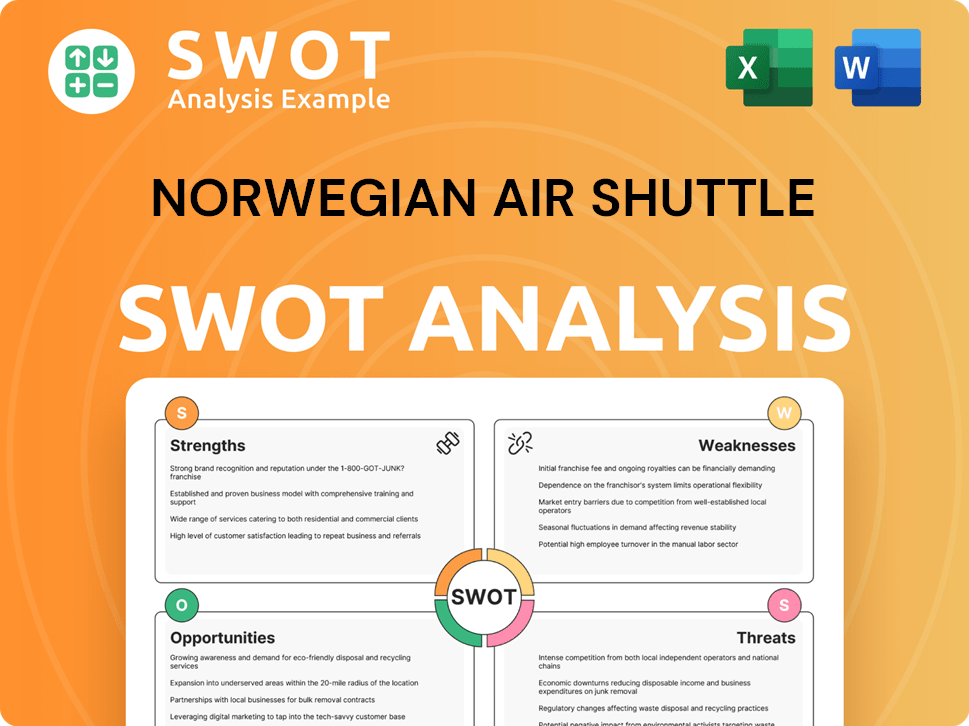
How Has Norwegian Air Shuttle’s Ownership Changed Over Time?
The ownership of Norwegian Air Shuttle has seen significant changes since its listing on the Oslo Stock Exchange on December 18, 2003. Initially, the founder, Bjørn Kjos, through HBK Holding AS, held the largest share, with 4.64% as of April 3, 2020. However, a major recapitalization in May 2020 reshaped the ownership structure, leading to a shift in major stakeholders.
Following the 2020 recapitalization, AerCap and BOC Aviation became prominent shareholders. The most recent data indicates further diversification. As of December 31, 2024, the ownership landscape includes Geveran Trading Company, Ltd. as a significant shareholder, alongside institutional investors like Folketrygdfondet and DNB Asset Management AS. The top 20 shareholders collectively held 53.7% ownership as of the same date, reflecting a transition from founder-led control to a more diversified shareholder base. The company's total operating revenue for 2024 was NOK 35.317 billion, a 38% increase from 2023.
| Shareholder | Percentage (December 31, 2024) | Notes |
|---|---|---|
| Geveran Trading Company, Ltd. | 14.53% | Major shareholder |
| Folketrygdfondet | 8.72% | Government pension fund manager |
| DNB Asset Management AS | 4.33% | Institutional investor |
| Ballyfin Aviation Limited | 3.27% |
As of May 31, 2025, institutional ownership in Norwegian Air Shuttle ASA stands at 20.22%. This highlights the increasing influence of institutional investors in the company's ownership structure. The shifts in ownership reflect the evolution of the company's financial strategy and investor base.
The ownership of Norwegian Air Shuttle has evolved from founder-led control to a more diversified structure.
- Geveran Trading Company, Ltd. is a major shareholder.
- Institutional investors hold a significant portion of the shares.
- The company's revenue increased significantly in 2024.
- The stock symbol for Norwegian Air is NAS ASA.
Norwegian Air Shuttle PESTLE Analysis
- Covers All 6 PESTLE Categories
- No Research Needed – Save Hours of Work
- Built by Experts, Trusted by Consultants
- Instant Download, Ready to Use
- 100% Editable, Fully Customizable
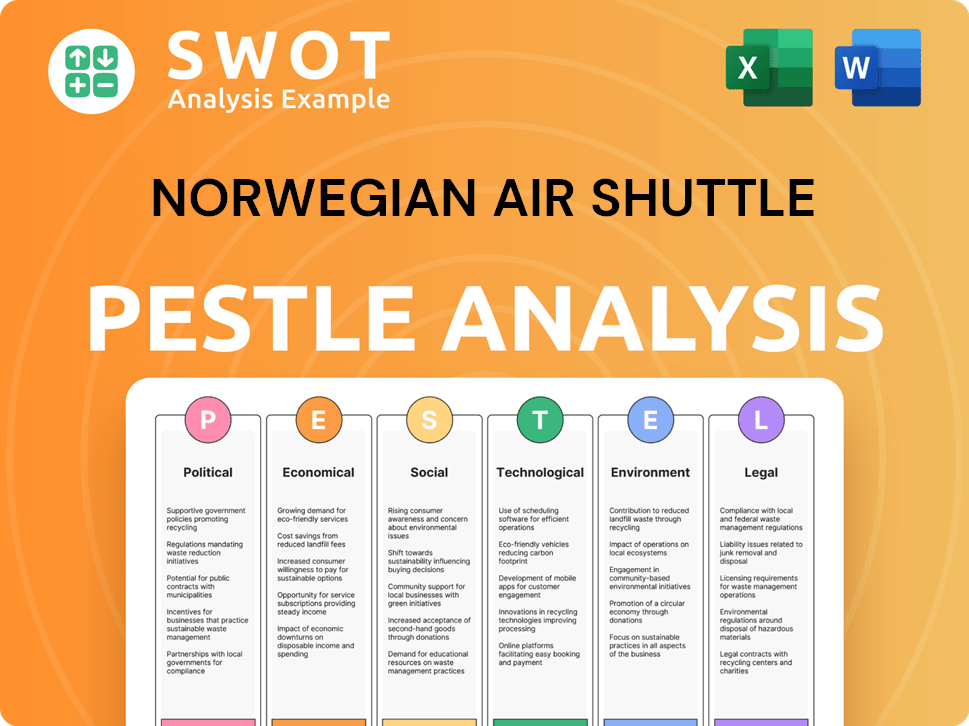
Who Sits on Norwegian Air Shuttle’s Board?
The current Board of Directors of Norwegian Air Shuttle ASA is pivotal in the company's governance. At the annual general meeting held on May 14, 2025, shareholders had the opportunity to vote in advance or submit a proxy. Understanding the composition and influence of the board is crucial for assessing the company's strategic direction and financial health, especially for those interested in the marketing strategy of Norwegian Air Shuttle.
Norwegian Air Shuttle ASA operates with a single class of shares, ensuring all shares possess equal voting rights, with one share equating to one vote. This structure, known as one-share-one-vote, typically encourages proportional representation based on shareholding. While specific details on board member representation from major shareholders versus independent seats are not provided in the available information, the presence of significant institutional investors suggests their potential influence through board representation or active engagement. The company's structure aims for equitable governance.
| Board Member | Role | Notes |
|---|---|---|
| Chairperson | To be updated | Details from the May 14, 2025, AGM |
| Board Member | To be updated | Details from the May 14, 2025, AGM |
| Board Member | To be updated | Details from the May 14, 2025, AGM |
There is no information available regarding individuals or entities with special voting rights, golden shares, or founder shares that would grant them outsized control beyond the standard one-share-one-vote principle. Recent reports have not indicated any major proxy battles, activist investor campaigns, or governance controversies. This indicates a relatively stable ownership and governance environment for Norwegian Air Shuttle.
The company's ownership structure is straightforward, with a focus on equal voting rights for all shareholders. This structure helps in understanding who owns Norwegian Air. Key aspects include:
- One-share-one-vote system promotes proportional representation.
- No special voting rights or golden shares are reported.
- Significant institutional investors likely influence board representation.
- The stock symbol for Norwegian Air is NAS.
Norwegian Air Shuttle Business Model Canvas
- Complete 9-Block Business Model Canvas
- Effortlessly Communicate Your Business Strategy
- Investor-Ready BMC Format
- 100% Editable and Customizable
- Clear and Structured Layout
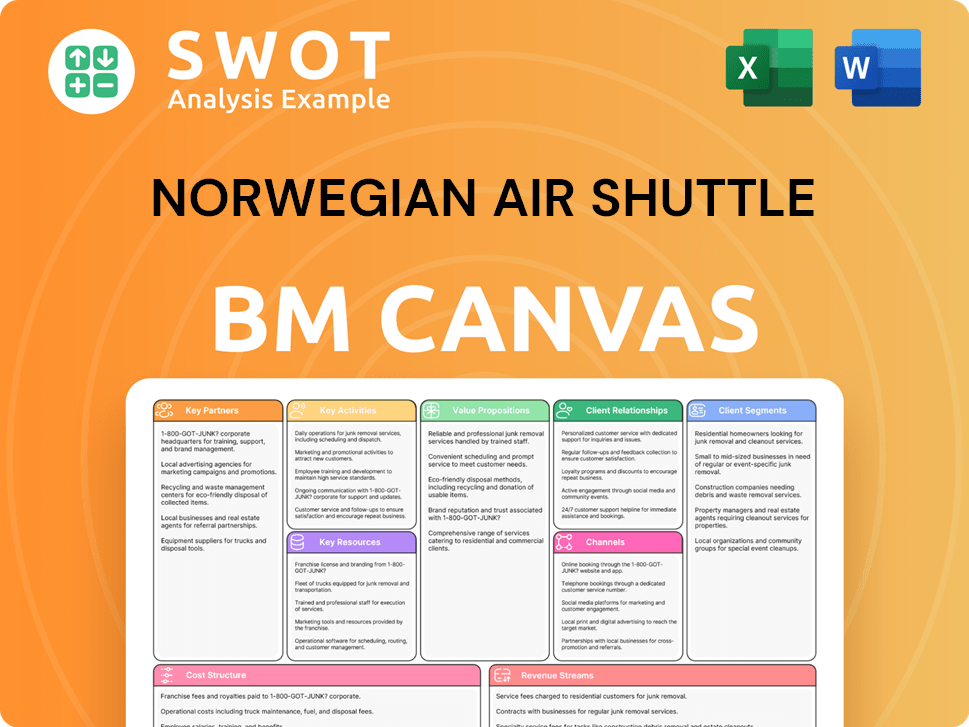
What Recent Changes Have Shaped Norwegian Air Shuttle’s Ownership Landscape?
In recent years, Norwegian Air Shuttle, also known as NAS ASA, has seen significant shifts in its ownership and strategic direction. A major recapitalization in May 2020 led to changes in the shareholder structure, with creditors like AerCap and BOC Aviation becoming prominent. More recently, in April 2025, the airline acquired 10 Boeing 737-800 aircraft previously leased, aiming for greater cost efficiency and operational flexibility.
A key development impacting the Norwegian Air ownership landscape was the acquisition of Widerøe, finalized at the start of 2024. This move significantly boosted Norwegian's market share in Norway to over 50% and increased the total employee count within the Norwegian Group to over 8,700. The Norwegian Air parent company has been undergoing strategic adjustments to streamline its operations and enhance its market position.
| Ownership Changes | Details | Date |
|---|---|---|
| Government Stake | Converted rescue loan to equity, acquiring a 6.37% stake. | May 2025 |
| Share Sale | Norwegian government sold its shares for NOK 892 million. | Recent |
| Founder's Share Sale | Bjørn Kjos sold 500,000 shares. | February 2025 |
| Institutional Ownership | 20.22% as of May 31, 2025 | May 31, 2025 |
The Norwegian Air shareholders have also seen activity. The Norwegian government converted part of its rescue loan into equity, gaining a 6.37% stake in May 2025, which involved issuing 65,582,436 new shares. Founder Bjørn Kjos also sold shares in February 2025. As of the end of Q1 2025, the company reported a robust financial position with NOK 10.5 billion in liquidity. For 2025, Norwegian projects a capacity growth rate of 4%, focusing on cost efficiency, a substantial decrease from the previous years.
Government converted rescue loan to equity.
Acquisition of Widerøe increased market share.
Strong liquidity of NOK 10.5 billion at the end of Q1 2025.
Focus on cost efficiency and capacity growth of 4% for 2025.
Norwegian Air Shuttle Porter's Five Forces Analysis
- Covers All 5 Competitive Forces in Detail
- Structured for Consultants, Students, and Founders
- 100% Editable in Microsoft Word & Excel
- Instant Digital Download – Use Immediately
- Compatible with Mac & PC – Fully Unlocked
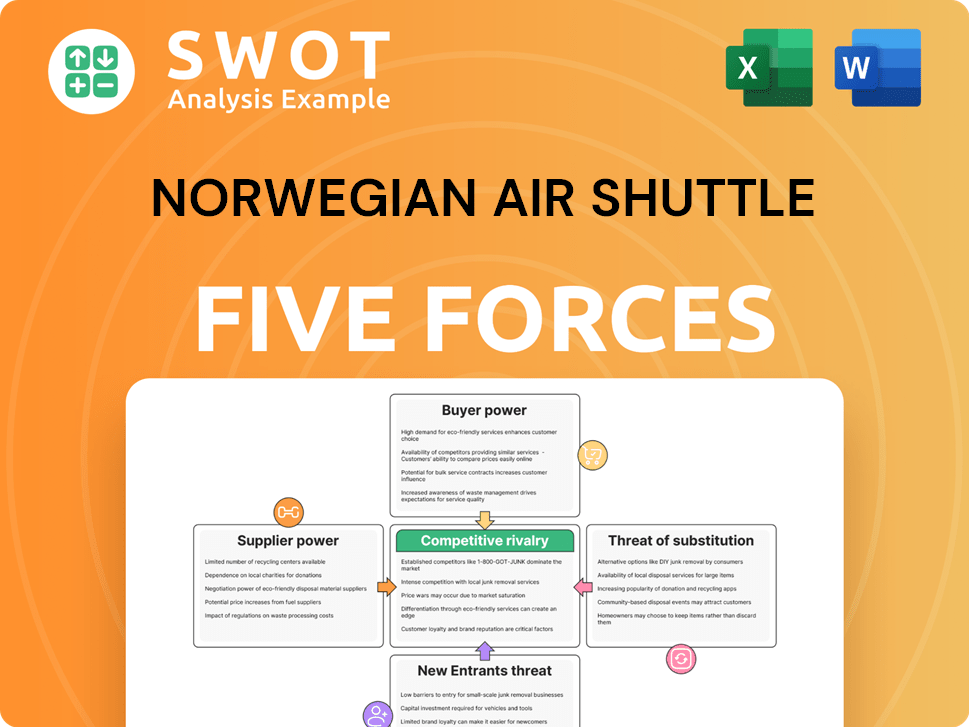
Related Blogs
- What are Mission Vision & Core Values of Norwegian Air Shuttle Company?
- What is Competitive Landscape of Norwegian Air Shuttle Company?
- What is Growth Strategy and Future Prospects of Norwegian Air Shuttle Company?
- How Does Norwegian Air Shuttle Company Work?
- What is Sales and Marketing Strategy of Norwegian Air Shuttle Company?
- What is Brief History of Norwegian Air Shuttle Company?
- What is Customer Demographics and Target Market of Norwegian Air Shuttle Company?
Disclaimer
All information, articles, and product details provided on this website are for general informational and educational purposes only. We do not claim any ownership over, nor do we intend to infringe upon, any trademarks, copyrights, logos, brand names, or other intellectual property mentioned or depicted on this site. Such intellectual property remains the property of its respective owners, and any references here are made solely for identification or informational purposes, without implying any affiliation, endorsement, or partnership.
We make no representations or warranties, express or implied, regarding the accuracy, completeness, or suitability of any content or products presented. Nothing on this website should be construed as legal, tax, investment, financial, medical, or other professional advice. In addition, no part of this site—including articles or product references—constitutes a solicitation, recommendation, endorsement, advertisement, or offer to buy or sell any securities, franchises, or other financial instruments, particularly in jurisdictions where such activity would be unlawful.
All content is of a general nature and may not address the specific circumstances of any individual or entity. It is not a substitute for professional advice or services. Any actions you take based on the information provided here are strictly at your own risk. You accept full responsibility for any decisions or outcomes arising from your use of this website and agree to release us from any liability in connection with your use of, or reliance upon, the content or products found herein.